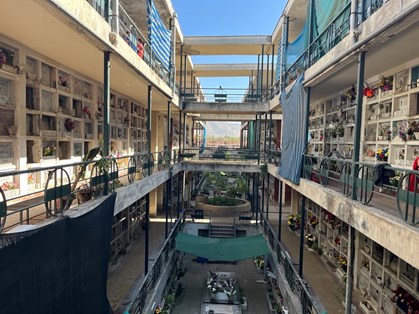The annual conference of the IAIS, the International Association of Insurance Supervisors, took place in Chile in November. Jochem van Stiphout was there and writes in a personal account what he noticed. "Diversity, equity and inclusion are high on the regulators' agenda."
Jochem van Stiphout is Senior Advisor European & International Affairs at the Dutch Association of Insurers. He spends a large part of his time in Brussels and represents the interests of Dutch insurers in Europe and worldwide. On 10 and 11 November he attended the annual conference of the International Association of Supervisors in Santiago.
Attention to DE&I
"What struck me most was that the topic of diversity, equity and inclusion (DE&I) is so prominent on the agenda of regulators. It was the focus of an extensive panel discussion as well as a lunch on women in the insurance industry. The importance of DE&I in the insurance world and in supervision has been emphasised from different perspectives, with the so-called ESG criteria (Environmental, Social and Governance) in particular playing a major role. These criteria form the basis of our view on sustainability. And where in recent years the focus has mainly been on the Environment pillar, that is now starting to shift to the social component and in particular to diversity, equality and inclusiveness."
 Jochem in Santiago de Chile
Jochem in Santiago de Chile
Role of supervisor
"I get that. After all, we have known for a long time that various organizations are more successful. They can better serve the different wishes of society. Simply because they are a reflection of that society. The chance that supervisors will come up with quotas or stress tests in the short term does not seem to me to be that great, but the subject is prominent on the agenda. Both at the IAIS and at the individual supervisors. During the conference, the IAIS issued a statement in which it once again emphasized the importance that regulators attach great importance to DE&I."
Long way
"For example, it is written that a diverse board of insurers leads to better corporate governance. In addition, the risk of tunnel vision is reduced. And finally, there is more focus on addressing protection gaps, which occur especially among minority groups. The IAIS also notes in the statement that steps have been taken, but there is still a long way to go. The association is therefore taking the lead and starting with an inventory of measures that have already been taken to promote diversity. The IAIS also wants to map the extent to which our sector is representative of society. There will undoubtedly be gaps in that, but then we will immediately know where there is still work to be done."
"The regulators are not worried about solvency, but insurers are of course not immune to inflation"
Consequences of inflation
"In addition to diversity, the IAIS could not avoid putting high inflation and the expected recession on the agenda. Although regulators are not directly concerned about the solvency of insurers, our sector is of course not immune to the financially uncertain times in which we live. It is not for nothing that the stress that the British pension sector has fallen into has been cited several times as a typical example. These are dangers that can also affect the insurance sector. Just think of the risk that many customers cancel their policy at the same time, because they have to cut back on their fixed costs. Or the increased costs, which require insurers to increase their premiums. Customers are then confronted with more costs, while they are looking for savings. In other words, inflation causes headaches, also for the regulators."
Brazilians as an example
"Was it mostly doom and gloom in Chile? No, certainly not. The great value of the conference for me personally was that I was able to speak to many supervisors and fellow associations. For example, from South America about technology in the insurance sector. But also with Japanese and Brazilian insurers about data sharing. The Brazilians are at the forefront of data sharing worldwide and the question arises what can we learn from this?"
An article about the Brazilian way of working will soon be published in our public newsletter. Not a subscriber yet? Then sign up immediately.
Mutually buried in Chile
The visit to Chile was also a great opportunity for Jochem van Stiphout to experience a different culture. It was precisely during his stay that All Souls' Day was celebrated, a Catholic holiday in which the deceased are commemorated. He was in Santiago at the time and was introduced to the funeral culture in Chile. "Through a kind of mutual you can be buried in a prominent place."
Funeral culture in Chile
"On November 2, I went to the General Cemetery of Santiago. The largest cemetery in Latin America where more than two million people are buried. It is nice to see how many Chileans are out that day, bringing flowers to the graves of their loved one or relatives. But also to drink wine. The funeral culture in Chile is very special anyway. Chileans find it important to be well buried and to get themselves a nice place. The cemetery of Santiago is also not, as with us, a rectangular area with rectangular graves, which are neatly lined up. It looks more like a complete village, with high-rise, low-rise buildings and a 'countryside'. There you can also see the lower, middle and upper layers of the population. In the free-standing temples the rich and the dignitaries are buried. It's like walking through a residential area. And in the countryside, with very small stones, the lower layer of the population finds its final resting place. However, the interesting thing is that there are various mutualidades active in Chile that you can also join as a 'simple' Chilean. As a result, everyone in Chile can be buried 'on stand'. Beautiful!"
 Cemetery in Santiago de Chile
Cemetery in Santiago de Chile
Was this article useful?

